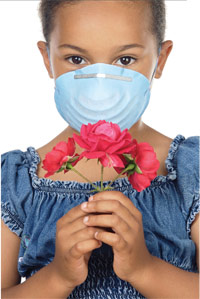Asthma is a chronic disease that affects the airways and makes breathing difficult. Symptoms normally associated with asthma include coughing, wheezing, shortness of breath, and tightness in the chest. Despite the availability of medicine or treatments for asthma, it remains a serious and sometimes dangerous disease.
Although the prevalence of asthma varies from country to country, yet the disparity shown between low and middle income countries is narrowing. There are an estimated 300 million people worldwide who suffer from asthma, with a quarter million deaths occurring annually as a result of asthma. The World Health Organisation (WHO) estimates the number of people with asthma to increase to more than 100 million in 2025. Out of this number, an estimated 70% also suffer from allergies.
How are allergies linked to asthma?
There are many risk factors that may lead to your child developing asthma. These include (but are not limited to) the presence of allergies, a family history of asthma or allergies, frequent respiratory infections, low birth weight, and exposure to tobacco smoke either before or after birth.
Although they appear different on the surface, allergies and asthma often go hand in hand. Many children with allergies go on to develop asthma months or years later. There are many types of allergies that may afflict your child, and they are usually triggered by specific substances (called allergens) that may cause an allergic reaction in your child’s body.
The presence of allergens which adversely affect your child’s breathing or airways can lead to asthma, especially if the situation is not rectified. These allergens could come from plants, animals, insects, or even household chemicals; examples of allergens would be pollen from trees/grass, mould, animal dander (from hair, skin, or feathers) and saliva, dust mites, and cockroaches.
How does an allergic reaction cause asthma symptoms?
An allergic reaction normally occurs when your child’s immune system goes into overdrive and mistakenly identifies a harmless substance such as tree pollen as a dangerous invader. This hyper-sensitivity of your child’s immune system is what causes him/her to suffer from allergies, and if he/she is constantly exposed to these allergens on a consistent basis, his/her allergies will very likely lead to asthma.
You will also need to keep in mind that while allergens can cause allergic reactions, other irritants can also trigger asthma-like attacks. These irritants include cigarette smoke, air pollutants (like smoke from open fires, etc.), cold air, strong chemical odours, perfumes, or other scented products.
The symptoms of allergic asthma
Common signs and symptoms of allergy include nasal congestion, a runny nose, itchy eyes, or skin reactions. For some people, this same reaction also affects the lungs and airways, leading to asthma symptoms like wheezing or other difficulties in breathing. If your child has allergic asthma, when his/her immune system overreacts to certain allergens, his/her airways are affected and the muscles around the airways will contract. His/her airways will become inflamed and drenched in mucus.
The symptoms of allergic asthma are about the same as asthma; your child may suffer from:
- Sudden bouts of coughing,
- Difficulty in breathing which leads to wheezing, shortness of breath, or rapid breathing,
- A feeling of tightness in the chest.
What can I do?
There are several things that you can do to alleviate your child’s allergies. Begin by teaching him/her good dietary habits. Eating healthy foods in the right amounts ensures long term benefits. You should also encourage your child to be more physically active. Many asthmatics have higher oxidative stress than healthier people, thus they will benefit more if they consume foods that are rich in antioxidants like fruits and vegetables.
It is also crucial that you limit your child’s exposure to allergens, especially in the home. It’s important to pay attention to this, especially during hazy weather. If you are at home, keep the windows closed, or if you have an air conditioner, you can use it to filter the air. You should also wash your child’s bed sheets more frequently to minimise dust mites. Other things you need to keep an eye out for include the type of soft toys (use washable stuffed toys), carpets, wallpapers, heavy curtains, and even piles of clothes. Dust mites and mould can be a problem if you do not maintain a clean environment.
Other than keeping your home environment under control, you may also need to get an expert opinion or diagnosis from a qualified paediatrician or a paediatric respiratory physician. He or she can better determine if your child requires medication, and can advise you with more clarity.







Komen